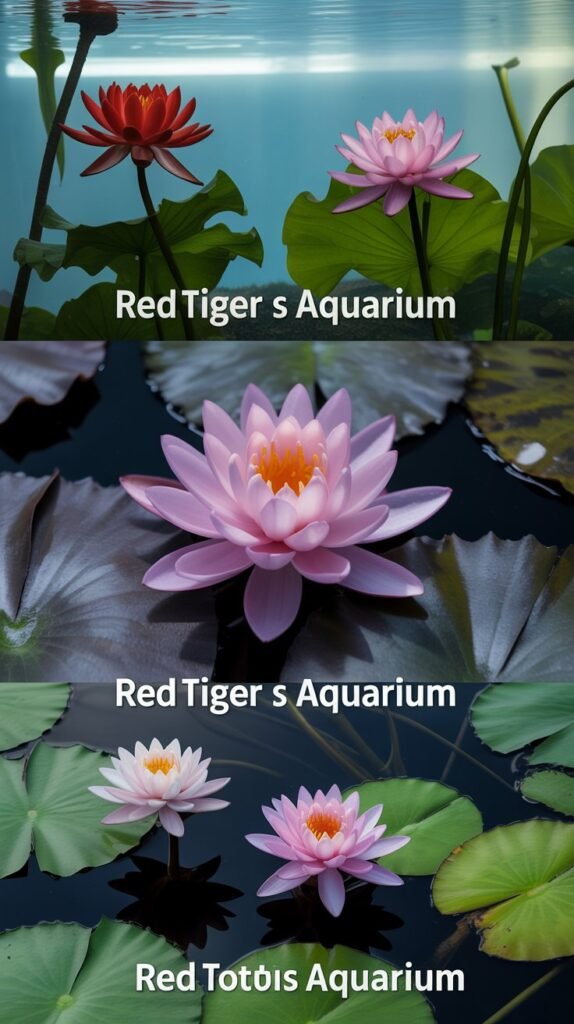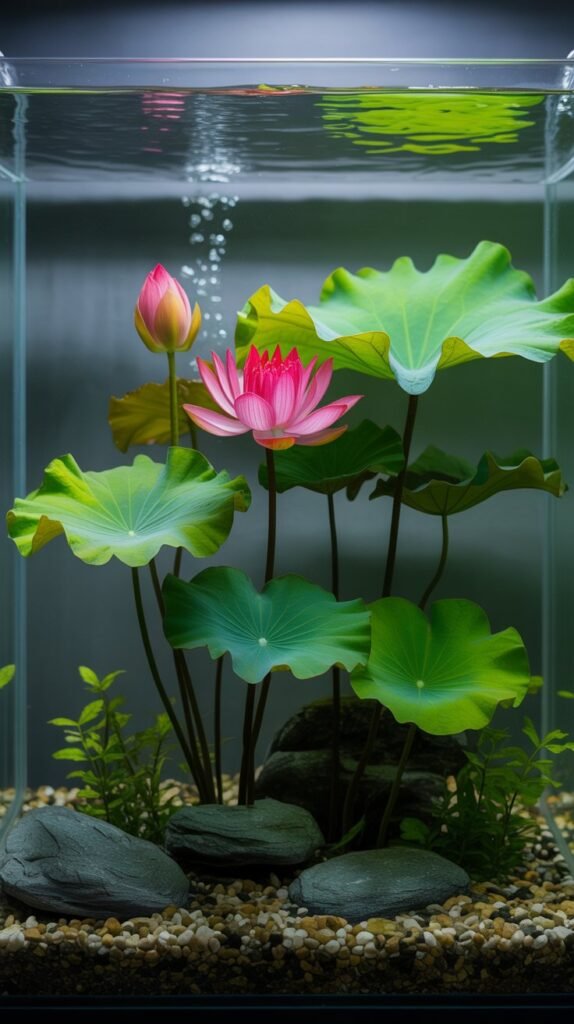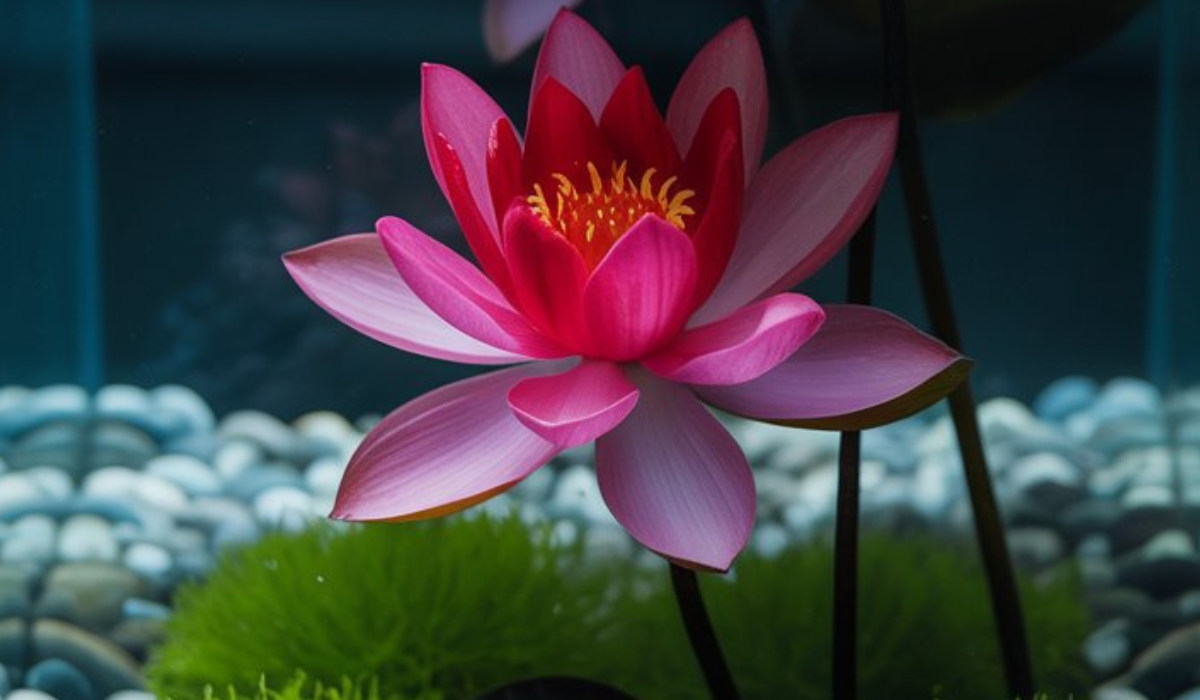When it comes to adding color, elegance, and natural vibrancy to your aquarium, few plants can rival the stunning Red Tiger Lotus (Nymphaea zenkeri). Known for its bold red and green leaves, graceful floating pads, and unique growth pattern, this plant brings an artistic touch to any aquascape.
Whether you’re an aquascaping enthusiast or a casual hobbyist, a Red Tiger Lotus aquarium can become the centerpiece of your aquatic world. However, its beauty also demands proper care, understanding, and maintenance to keep it thriving and under control.
In this detailed guide, we’ll explore everything you need to know about the Red Tiger Lotus, including its origin, care requirements, propagation methods, aquarium placement, lighting needs, and frequently asked questions.
What Is the Red Tiger Lotus?
The Red Tiger Lotus (scientific name: Nymphaea zenkeri) is a type of aquatic lily native to tropical regions of West Africa. It belongs to the Nymphaeaceae family and is closely related to water lilies found in ponds and lakes.
In aquariums, the Red Tiger Lotus is prized for its large, vibrant leaves that range in color from green to deep red, often with striking marbled or spotted patterns. It grows both submerged and floating leaves, adding vertical height and dramatic visual contrast to aquascapes.
Why Choose Red Tiger Lotus for Your Aquarium?

The Red Tiger Lotus is one of the most visually captivating aquatic plants you can add to your aquarium. Here are some reasons why aquarists love it:
1. Striking Color and Texture
Unlike most green aquatic plants, the Red Tiger Lotus brings shades of deep red, copper, and burgundy, creating a vibrant focal point. The contrast enhances any aquascape, especially those dominated by green plants.
2. Great for Aquascaping
Its broad leaves and elegant growth pattern make it ideal for midground or background placement. When properly trimmed, it can serve as a stunning centerpiece in planted tanks.
3. Oxygenates the Water
Like all live plants, Red Tiger Lotus helps oxygenate water, absorb waste compounds, and stabilize water chemistry.
4. Provides Shelter
Its large leaves create shaded areas for fish and shrimp, reducing stress and mimicking natural habitats.
5. Easy to Grow
Despite its exotic appearance, the Red Tiger Lotus is relatively easy to care for, adaptable, and forgiving of minor fluctuations in tank conditions.
Scientific Classification
| Category | Details |
|---|---|
| Scientific Name | Nymphaea zenkeri |
| Common Name | Red Tiger Lotus |
| Family | Nymphaeaceae |
| Origin | West Africa |
| Growth Form | Bulb-based aquatic plant |
| Growth Rate | Moderate to Fast |
| Lighting Requirement | Medium to High |
| CO₂ Requirement | Optional but beneficial |
| Temperature Range | 22–28°C (72–82°F) |
| pH Level | 6.0–7.5 |
| Hardness | Soft to moderately hard |
| Placement | Midground to Background |
Red Tiger Lotus Aquarium Setup
Creating the ideal environment for your Red Tiger Lotus aquarium is the key to keeping it healthy and vibrant.
1. Tank Size
While this plant can grow in smaller tanks, it thrives best in 20 gallons (75 liters) or larger aquariums. This gives the roots and leaves enough space to spread without crowding other plants.
2. Substrate
Red Tiger Lotus is a root-feeding plant, meaning it absorbs most of its nutrients from the substrate.
Use:
- Nutrient-rich substrate (like ADA Amazonia or Fluval Stratum), or
- Fine gravel/sand with root tabs added monthly.
Ensure the bulb is half-buried, with the top part exposed, to prevent rotting.
3. Water Parameters
- Temperature: 22–28°C (72–82°F)
- pH: 6.0–7.5
- Hardness: 3–15 dGH
- Flow: Gentle to moderate
Soft, slightly acidic water best mimics its natural African environment.
4. Lighting
The Red Tiger Lotus thrives under medium to high lighting. Strong light encourages the development of red pigmentation in the leaves.
- Under low light, the plant remains mostly green.
- Under intense light, leaves turn deep red or burgundy.
Aim for 8–10 hours of lighting daily. Use LED aquarium lights for consistent and adjustable brightness.
5. CO₂ and Fertilization
While CO₂ is not mandatory, adding it greatly improves growth rate, color intensity, and leaf size.
Supplement with:
- Root tabs every 4–6 weeks.
- Liquid fertilizers containing iron and potassium once a week.
Iron is especially important — it enhances the deep red hue that makes this plant stand out.
How to Plant Red Tiger Lotus in an Aquarium

Planting the Red Tiger Lotus correctly ensures healthy growth and prevents bulb rot.
Step-by-Step Planting Guide
- Inspect the Bulb:
Before planting, check that the bulb is firm, not mushy. A soft bulb indicates decay. - Positioning the Bulb:
Place it on top of the substrate or bury only the bottom half of the bulb. Never cover it completely, as this restricts oxygen and leads to rot. - Anchor It (Optional):
If the bulb floats, gently anchor it with a rock or bury it slightly until it settles naturally. - Allow It to Sprout:
Within 1–2 weeks, you’ll notice new shoots emerging. Once the roots develop, the bulb will anchor itself.
Growth and Development
The Red Tiger Lotus grows moderately fast under proper conditions. It typically produces:
- Submerged leaves (underwater)
- Floating leaves (surface level)
Controlling Floating Leaves
While floating leaves add beauty and shade, they can block light for other plants. To control this:
- Trim floating leaves regularly.
- Encourage underwater growth by cutting stems before they reach the surface.
Maintenance and Care Tips
Though hardy, the Red Tiger Lotus benefits from consistent care. Here’s how to keep it thriving:
1. Regular Trimming
Trim older or larger leaves to prevent overcrowding and maintain tank balance. Always cut stems close to the base using aquarium scissors.
2. Control Overgrowth
This plant can grow large and overshadow others. Limit the number of leaves reaching the surface and prune often to maintain aesthetics.
3. Monitor Nutrients
Deficiency signs include:
- Pale leaves → Iron deficiency
- Holes or melting leaves → Lack of potassium or CO₂
Add fertilizers accordingly.
4. Water Changes
Perform 20–30% weekly water changes to remove excess nutrients and prevent algae.
5. Avoid Overheating
Although tropical, it dislikes excessive heat. Maintain temperatures below 82°F (28°C) for best results.
Common Problems and Solutions
Even hardy plants can face challenges. Here’s how to handle the most common Red Tiger Lotus issues:
| Problem | Cause | Solution |
|---|---|---|
| Bulb Rotting | Buried too deep | Keep bulb half-exposed |
| Pale Green Leaves | Low iron or light | Add iron fertilizer or increase lighting |
| Holes in Leaves | Nutrient deficiency | Add potassium supplement |
| Algae Growth | Too much light or excess nutrients | Reduce light duration; add algae-eaters |
| Leaves Reaching Surface Too Quickly | High nutrient load | Trim regularly to control growth |
Propagation of Red Tiger Lotus
One of the most fascinating aspects of this plant is how easily it propagates.
1. Daughter Plant Formation
As the plant matures, it produces daughter plants from the bulb. These small offshoots develop their own roots and leaves.
- Wait until the daughter plant grows 3–4 leaves.
- Gently separate it from the parent bulb.
- Replant it in another area of the aquarium or a new tank.
2. Seed Propagation (Rare)
In some cases, the Red Tiger Lotus produces flowers and seeds when allowed to grow above the surface. However, this is uncommon in aquariums and mostly seen in open-top setups or ponds.
Ideal Aquascaping Uses
Red Tiger Lotus is one of the most versatile plants for aquascaping. It can completely transform the mood of your aquarium.
1. Centerpiece Plant
Use it as a focal point in medium or large tanks. Its bold color and size naturally draw attention.
2. Background Accent
When combined with taller plants like Vallisneria or stem plants, it adds color contrast and depth.
3. Low-Tech Aquascapes
Even in tanks without CO₂ or complex fertilizers, it grows beautifully, provided lighting and substrate are adequate.
4. Biotope and Nature Aquariums
It fits perfectly in African biotope aquariums, where it replicates the plant’s natural riverine habitat.
Tank Mates for Red Tiger Lotus
The Red Tiger Lotus is peaceful and compatible with most community fish.
Recommended Fish:
- Tetras (Neon, Cardinal, Ember)
- Rasboras
- Guppies and Endlers
- Angelfish
- Gouramis
- Shrimp and Snails (Amano, Nerite, Cherry Shrimp)
Avoid:
- Goldfish (they’ll uproot and eat it)
- Large Cichlids (they may damage leaves)
- Plecos (they can graze on soft leaves)
Benefits of Red Tiger Lotus in an Aquarium
- Natural Beauty: Enhances aquascape color diversity.
- Water Filtration: Absorbs nitrates, reducing algae growth.
- Oxygenation: Promotes healthy tank environment.
- Shelter: Offers cover for shy fish and fry.
- Stability: Contributes to a balanced ecosystem.
Red Tiger Lotus vs. Green Tiger Lotus
| Feature | Red Tiger Lotus | Green Tiger Lotus |
|---|---|---|
| Leaf Color | Red to burgundy | Green to light brown |
| Lighting Need | Medium–High | Low–Medium |
| Growth Rate | Moderate–Fast | Moderate |
| Aesthetic Impact | Bold and dramatic | Natural and subtle |
| Best For | Highlight or focal plant | Background greenery |
Both are stunning, but the Red Tiger Lotus stands out for its vibrant color and visual dominance.
Safety Tips
- Always quarantine new plants before introducing them to your main tank to prevent pests like snails or algae.
- Handle bulbs carefully — damaged bulbs rot quickly.
- Avoid using copper-based medications in tanks with Red Tiger Lotus, as they harm both plants and shrimp.
Where to Buy Red Tiger Lotus
You can find Red Tiger Lotus bulbs or plants from:
- Local aquarium stores
- Online aquarium plant retailers (like Aquarium Co-Op, BucePlant, or AquaHabitats)
- Aquatic plant trading groups
Choose bulbs that are firm, brown, and not slimy. Avoid any with foul odor or mold.
Conclusion
The Red Tiger Lotus is a true showstopper in any aquarium. Its dramatic red hues, elegant leaf structure, and easy care make it one of the most beloved plants among aquascapers. Whether you use it as a centerpiece, a colorful accent, or part of a lush aquascape, this plant transforms your aquarium into a breathtaking aquatic garden.
With proper lighting, nutrient-rich substrate, and occasional trimming, your Red Tiger Lotus aquarium will thrive — offering both beauty and ecological balance.
Frequently Asked Questions (FAQs)
1. Is the Red Tiger Lotus easy to grow?
Yes. It’s a hardy and adaptable plant that thrives in a range of conditions, making it suitable for both beginners and experienced aquarists.
2. Why is my Red Tiger Lotus bulb rotting?
If the bulb is completely buried, it can suffocate and rot. Keep the top half exposed to prevent decay.
3. How tall can Red Tiger Lotus grow?
It can reach up to 20 inches (50 cm), depending on tank size and lighting.
4. Can Red Tiger Lotus grow without CO₂?
Yes. It grows well in low-tech tanks, though CO₂ enhances color and leaf size.
5. How do I make the leaves more red?
Provide strong lighting and iron-rich fertilizers to intensify the red pigmentation.
6. Do I need to trim floating leaves?
Yes, trimming helps control growth and prevents shading other plants.
7. Can Red Tiger Lotus flower underwater?
It usually flowers above the surface, producing small white or purple blooms in open-top aquariums.
8. Is Red Tiger Lotus safe for shrimp and snails?
Absolutely. It provides excellent cover and does not harm invertebrates.
9. How fast does Red Tiger Lotus grow?
Under ideal conditions, new leaves appear every 1–2 weeks.
10. Can Red Tiger Lotus survive in a low-light tank?
It will survive but remain mostly green and grow slower. For best coloration, use medium to high light.

